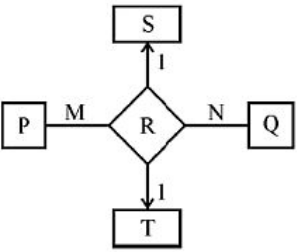UGC NET CS 2006 Dec-paper-2
May 20, 2024Algorithms
May 20, 2024ER-Model
| Question 30 |
Consider the following Entity-Relationship (E-R) diagram and three possible relationship sets (I, II and III) for this E-R diagram:


If different symbols stand for different values (e.g., t1 is definitely not equal to t2 ) , then which of the above could not be the relationship set for the E-R diagram ?


If different symbols stand for different values (e.g., t1 is definitely not equal to t2 ) , then which of the above could not be the relationship set for the E-R diagram ?
| I only | |
| I and II only | |
| II only | |
| I, II and III |
Question 30 Explanation:
In the given E-R diagram there is Many-To-Many relationship between entity P and Q it means single value in P can relate to Multiple values in Q and vice-versa. And there is One-To-One
relationship between S and T it means single value in S can relate to single value in T and vice-versa .
In table1: there is One to many relationship between S and T because “s1” in S attribute related with two values “t1” and “t2” in T attribute. so this table is violating One-to-One relationship of S and T as shown in E-R diagram so it can’t be the relationship set of given E-R diagram.
In Table 2: There is one to one relationship between S and T and In P and Q also many-to many relationship constraints are not violated. So it could be the relationship set of given E-R diagram.
In Table 3: “p1” in P attribute is related with two values in Q attribute so many to many relationship constraints are not violate here and S and T attributes are also obeying one-to-one relationship constraints. So it could be the relationship set of given E-R diagram.
relationship between S and T it means single value in S can relate to single value in T and vice-versa .
In table1: there is One to many relationship between S and T because “s1” in S attribute related with two values “t1” and “t2” in T attribute. so this table is violating One-to-One relationship of S and T as shown in E-R diagram so it can’t be the relationship set of given E-R diagram.
In Table 2: There is one to one relationship between S and T and In P and Q also many-to many relationship constraints are not violated. So it could be the relationship set of given E-R diagram.
In Table 3: “p1” in P attribute is related with two values in Q attribute so many to many relationship constraints are not violate here and S and T attributes are also obeying one-to-one relationship constraints. So it could be the relationship set of given E-R diagram.
Correct Answer: A
Question 30 Explanation:
In the given E-R diagram there is Many-To-Many relationship between entity P and Q it means single value in P can relate to Multiple values in Q and vice-versa. And there is One-To-One
relationship between S and T it means single value in S can relate to single value in T and vice-versa .
In table1: there is One to many relationship between S and T because “s1” in S attribute related with two values “t1” and “t2” in T attribute. so this table is violating One-to-One relationship of S and T as shown in E-R diagram so it can’t be the relationship set of given E-R diagram.
In Table 2: There is one to one relationship between S and T and In P and Q also many-to many relationship constraints are not violated. So it could be the relationship set of given E-R diagram.
In Table 3: “p1” in P attribute is related with two values in Q attribute so many to many relationship constraints are not violate here and S and T attributes are also obeying one-to-one relationship constraints. So it could be the relationship set of given E-R diagram.
relationship between S and T it means single value in S can relate to single value in T and vice-versa .
In table1: there is One to many relationship between S and T because “s1” in S attribute related with two values “t1” and “t2” in T attribute. so this table is violating One-to-One relationship of S and T as shown in E-R diagram so it can’t be the relationship set of given E-R diagram.
In Table 2: There is one to one relationship between S and T and In P and Q also many-to many relationship constraints are not violated. So it could be the relationship set of given E-R diagram.
In Table 3: “p1” in P attribute is related with two values in Q attribute so many to many relationship constraints are not violate here and S and T attributes are also obeying one-to-one relationship constraints. So it could be the relationship set of given E-R diagram.
